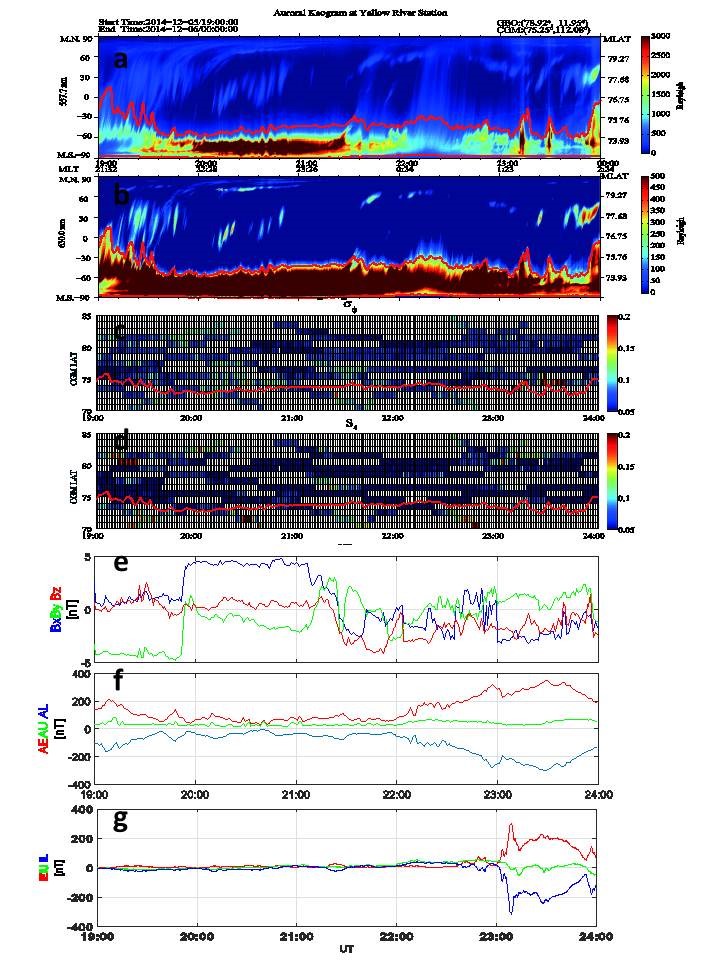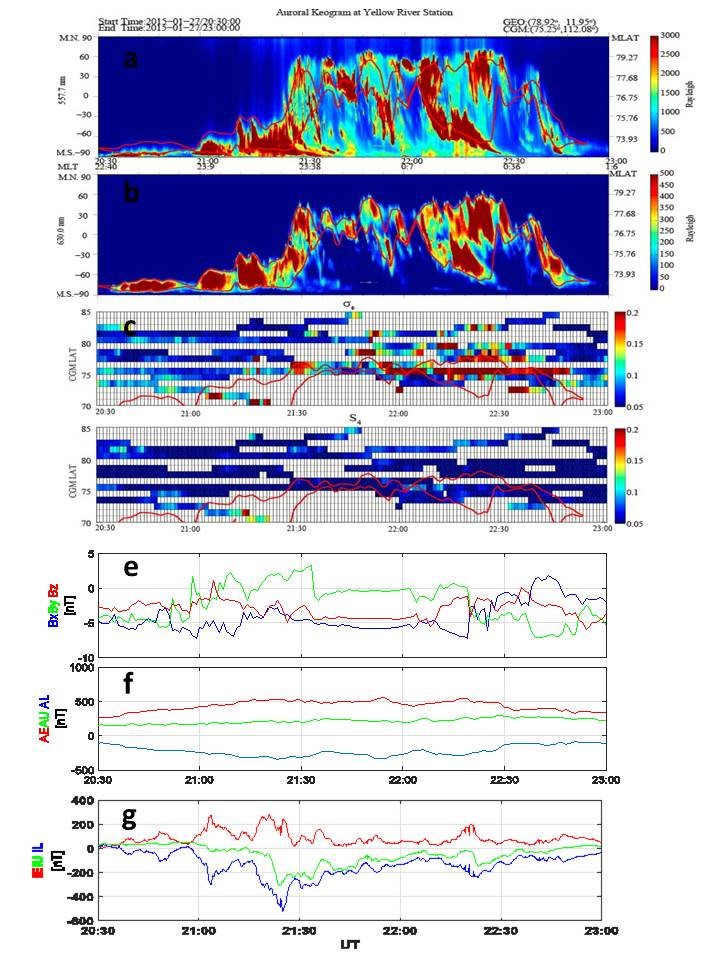The behaviors of ionospheric scintillations around different types of nightside auroral boundaries seen at YRS (Shishir Priyadarshi1, Qing-He Zhang, Yuzhang Ma, Zanyang Xing, Ze-Jun Hu, Guozhu Li) Dynamical nightside auroral structures are often observed by the all sky imagers (ASI) at the Chinese Yellow River Station (CYRS) at Ny-Ålesund, Svalbard, located in the polar cap near poleward edge of the nightside auroral oval. The boundaries of the nightside auroral oval are stable during quiet geomagnetic conditions, while they often expand poleward and pass through the overhead area of CYRS during the substorm expansion phase. The motions of these boundaries often give rise to strong disturbances of satellite navigations and communications. In this paper, two cases of these auroral boundary motions have been introduced to investigate their associated ionospheric scintillations. One is Fixed Boundary Auroral Emissions (FBAE) with stable and fixed auroral boundaries, and another is Bouncing Boundary Auroral Emissions (BBAE) with dynamical and largely expanding auroral boundaries. Our observations show that the auroral boundaries, identified from the sharp gradient of the auroral emission intensity from the ASI images, were clearly associated with ionospheric scintillations observed by Global Navigation Satellite System (GNSS) scintillation receiver at the CYRS. However, amplitude scintillation (S4) and phase scintillation (σφ) respond in an entirely different way in these two cases due to the different generation mechanism as well as different IMF (Interplanetary Magnetic Field) condition. S4 and σφ have similar levels around the FBAE, while σφ was much stronger than S4 around BBAE. The BBAE were associated with stronger particle precipitation during the substorm expansion phase. IU/IL, appeared to be a good indicator of the poleward moving auroral structures during the BBAE as well as FBAE. Figure 1a and 1b show the auroral emission keograms along the magnetic meridian at 557.7 nm and 630.0 nm respectively observed at the CYRS, Svalbard between 19:00-24:00 UT (21:32-02:24 MLT) on 5 December, 2014. Figure 1c and 1d present the σφ and S4 behavior during the auroral event, this map has been created by averaging the scintillation index for the bin size 1 ᴼ MLAT x 1 UT minute. Figure 1e and 1f show the IMF conditions and AE index. 
Figure 1. An example of the Fixed Boundary Auroral Emission (FBAE) 
Figure 2. An example of the Bouncing Boundary Auroral Emission (BBAE) Compared with the FBAE and BBAE, we can get these conclusions as follows: 1. The auroral emissions are a consequence of extremely localized ionospheric irregularities. Amplitude and phase scintillation regions are co-located with the intense auroral emissions. We have very limited scintillation observations during the FBAE as compared to the BBAE, however, the S4 and σφ both are quite equivalent during the FBAE. But, during the BBAE, σφ seems more promising. 2. FBAE is mostly due to the precipitation of few keV particles during the quiet geomagnetic condition (Meng, 1981; Lassen and Danielsen, 1989). The IMF By/Bz was changing its sign throughout the FBAE. However, BBAE is the results of large precipitation of the energetic particles during the disturbed geomagnetic condition. 3. A significant and nearly constant southward IMF Bz, steady negative/positive value of IMF By and AE (auroral electrojet) index of ~400 or more), is more likely to generate BBAE and strong phase scintillations. 4. BBAE seems mostly due to the irregularities generated through the large-scale structured fluxes of precipitated electrons near the magnetic midnight regions. 5. The east/west nightside auroral ionospheric current components, IU and IL turned to a significant negative value during the poleward movement of the auroral structures. During the FBAE, IU and IL, have mostly zero numerical value throughout the auroral emission. However, they were, significantly negative during the BBAE’s poleward auroral emission structure shrink. The paper “The behaviors of ionospheric scintillations around different types of nightside auroral boundaries seen at the Chinese Yellow River Station, Svalbard”(doi: 10.3389/fspas.2018.00026) by S. Priyadarshi, Q.-H. Zhang, Yuzhang Ma, Zanyang Xing, Ze-Jun Hu and Guozhu Li has been accepted by Front. Astron. Space Sci. and will be published in the near future. |
